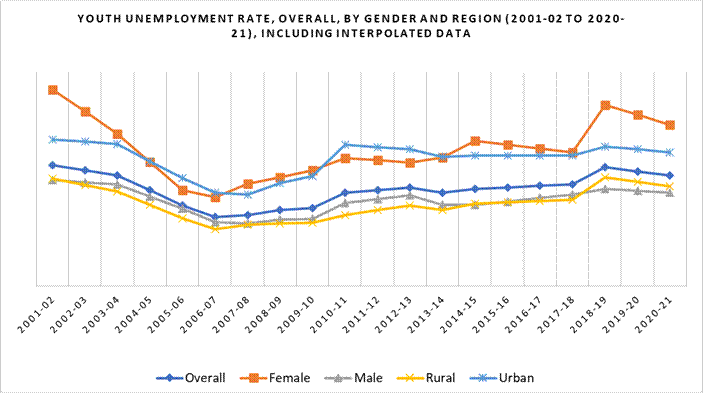Labour Force Indicators
Series No. 1 (December 2024)
Estimation By: Dr Umer Khalid Director of Research, Pride Pakistan
PRIDE Consulting estimated the series of youth (ages 15-29) using microdata from various issues of the Labour Force Survey. The Pakistan Bureau of Statistics (PBS) conducted 14 rounds of the Labour Force Survey (LFS) between 2001-02 and 2020-21. Values for six missing years, during which the LFS was not conducted, have been interpolated (indicated as underlined) to create a consistent time series. This consistent time series is a valuable tool for researchers and policymakers, offering a comprehensive and reliable dataset to analyze youth unemployment trends over time.
By disaggregating the data by gender and region, it helps identify specific areas and groups most affected by youth unemployment, enabling the design of targeted interventions and efficient resource allocation. The series allows policymakers to track the effectiveness of past policies, assess the impact of new measures, and monitor progress toward national employment goals. For researchers, it provides opportunities to explore the causes and consequences of youth unemployment, facilitating comparative studies and evidence-based policymaking. Ultimately, this time series supports the development of informed, sustainable policies that address emerging challenges and improve youth labor market outcomes.
| Years | Overall | Female | Male | Rural | Urban |
| 2001-02 | 11.3 | 18.38 | 9.94 | 10.06 | 13.72 |
| 2002-03 | 10.82 | 16.32 | 9.72 | 9.45 | 13.51 |
| 2003-04 | 10.34 | 14.25 | 9.5 | 8.84 | 13.29 |
| 2004-05 | 8.95 | 11.62 | 8.36 | 7.58 | 11.69 |
| 2005-06 | 7.56 | 8.98 | 7.21 | 6.32 | 10.09 |
| 2006-07 | 6.45 | 8.31 | 5.98 | 5.34 | 8.72 |
| 2007-08 | 6.64 | 9.56 | 5.87 | 5.77 | 8.56 |
| 2008-09 | 7.1 | 10.19 | 6.23 | 5.89 | 9.66 |
| 2009-10 | 7.3 | 10.83 | 6.26 | 5.91 | 10.29 |
| 2010-11 | 8.74 | 11.97 | 7.75 | 6.65 | 13.22 |
| 2011-12 | 8.99 | 11.78 | 8.13 | 7.10 | 13.01 |
| 2012-13 | 9.23 | 11.58 | 8.51 | 7.55 | 12.8 |
| 2013-14 | 8.71 | 12.06 | 7.59 | 7.13 | 12.10 |
| 2014-15 | 9.11 | 13.60 | 7.59 | 7.73 | 12.21 |
| 2015-16 | 9.24 | 13.25 | 7.92 | 7.84 | 12.22 |
| 2016-17 | 9.37 | 12.90 | 8.25 | 7.95 | 12.23 |
| 2017-18 | 9.49 | 12.54 | 8.57 | 8.06 | 12.24 |
| 2018-19 | 11.11 | 16.95 | 9.08 | 10.20 | 13.06 |
| 2019-20 | 10.72 | 16.03 | 8.91 | 9.77 | 12.80 |
| 2020-21 | 10.33 | 15.1 | 8.74 | 9.34 | 12.53 |
| Difference/range* | -0.97 | -3.28 | -1.2 | -0.72 | -1.19 |
Source: Pakistan Bureau of Statistics (PBS), Labour Force Survey, various issues, *The difference or range between the latest and oldest years (2020-21 and 2001-02) has been calculated.
Main Findings:
Female Youth at Risk: Female youth unemployment, although declining, remains alarmingly high, indicating persistent gender-based barriers to employment.
Urban Challenges: Urban areas consistently show higher unemployment rates, highlighting structural challenges in creating urban jobs.
Policy Implications: Tailored interventions focusing on gender and regional disparities, particularly in urban areas and for young women, are essential to address youth unemployment sustainably.

Source: Pakistan Bureau of Statistics (PBS), Labour Force Survey, various issues,

